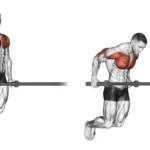Hanging Leg Raise: Exercise Overview
The hanging leg raise is an advanced bodyweight core exercise performed by suspending from a pull-up bar and raising straight legs to target the abdominal muscles, with a primary focus on the lower rectus abdominis. It also engages the hip flexors, obliques, and stabilizing muscles in the shoulders, forearms, and upper back due to the hanging position and grip demands.
This exercise excels at building core strength, enhancing abdominal definition, and improving overall body control, making it a staple for athletes, calisthenics enthusiasts, and those pursuing functional fitness. Beginners may start with hanging knee raises to build strength before progressing to the straight-leg version. The hanging leg raise is ideal for core workouts, full-body routines, or gymnastics-inspired training sessions (McGill, 2010).
How to Perform the Hanging Leg Raise
- Grip a pull-up bar with an overhand (pronated) grip, hands shoulder-width apart, and hang with your arms fully extended and feet off the ground.
- Engage your core and slightly brace your shoulders to stabilize your body and minimize swinging—this is your starting position.
- Slowly raise your legs in front of you, keeping them straight, until they reach hip or chest height, depending on your range of motion.
- Pause for 1–2 seconds at the top, squeezing your abdominal muscles for maximum contraction.
- Lower your legs back to the starting position with control, avoiding any swinging or momentum.
- Repeat for the desired number of repetitions.
Modification: Beginners can perform hanging knee raises, bending at the knees to reduce intensity while maintaining proper form.
Tips for Optimal Performance
- Minimize Swinging: Keep your body stable by engaging your core and shoulders, using slow, controlled movements to avoid momentum and maximize muscle activation (Schoenfeld, 2016).
- Protect Your Lower Back: Tighten your abs before lifting your legs to maintain a neutral spine and reduce strain on the lower back (McGill, 2010).
- Keep Legs Straight: Avoid bending your knees during the raise to fully engage the lower abs, but only lift as high as you can without arching your back.
- Breathe Properly: Exhale as you lift your legs and inhale as you lower them to support controlled movement and muscle oxygenation.
- Grip Tightly: Maintain a firm grip on the bar to enhance shoulder and forearm stability, ensuring you can focus on the core movement.
- Progress Gradually: Start with knee raises if the straight-leg version is too challenging, building strength to perform the full exercise safely (Wirth et al., 2016).
Forging a strong core with hanging leg raises? Discover their place in our Ultimate Guide to Muscle Groups for abs training.







